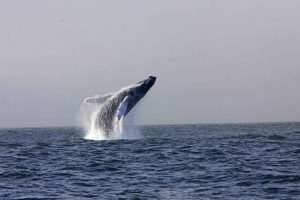 The female marsh harrier rose over the reed bed. For a fleeting moment she was master of the air… and then the wind hit her. Any illusion of aerial mastery was shattered as the Atlantic squall buffeted the hapless bird. It was all she could do to stay airborne.
The female marsh harrier rose over the reed bed. For a fleeting moment she was master of the air… and then the wind hit her. Any illusion of aerial mastery was shattered as the Atlantic squall buffeted the hapless bird. It was all she could do to stay airborne.
This was my first time seeing a marsh harrier in Ireland, so despite the fact that she wasn’t at her elegant and effortless best, the fact I was looking at her at all was a real bonus. It’s the sort of gem that Cape Clear throws up out of the blue. But I wasn’t here to look at birds (well, not primarily anyway). I was here to look at — or more accurately, to learn how to look for — cetaceans.
I’d bunked out of class at the Irish Whale and Dolphin Group’s (IWDG) summer Whale Watching course when news of the harrier broke, but was back in my seat almost before I was missed. Padraig Whooley, the IWDG’s sightings Coordinator, was telling us all about where, when and how to watch whales and dolphins from the shore in Ireland. Irish waters were declared Europes first official whale and dolphin sanctuary back in 1991, and are home to 24 recorded species of whales, dolphins and porpoise. The Irish coastline, particularly the southwest and southeast, has earned a deserved reputation as one of the best land-based whale-watching locations in Europe. But to get the most out of it you have to know what to look for. Hence the course.
You’d be hard pressed to find a better location than Cape Clear for a land based whale watching course. Firstly you get off the mainland — which is brilliant because the moment you step onto the ferry at Baltimore you leave your worries and stresses behind, so you’re less distracted. Secondly, where better for a whale watching weekend than an island sticking out into the Atlantic with fantastic elevated vistas of the open sea all around? It’s perfect.
After the classroom based Saturday morning session we followed Padraig up onto one of Cape Clear’s southerly headlands to put our new-found skills into practice. Out on that slender finger of rock jutting into the Atlantic the sun was shining, and the views were spectacular, but the same wind that had been causing the marsh harrier grief earlier in the day was also scuppering our chances of spotting cetaceans.
One of the key things we’d learnt in the classroom was that the best conditions for spotting whales and dolphins are clear days with good visibility and calm seas. Calm water means you can spot the tell-tale disturbances on the surface that can alert you to whale and dolphin activity. The sea that day was anything but calm. The wind also hampered the other great indicator of cetacean action: diving seabirds. Gannets and other birds that dive for prey tend to be visual predators. The chances of them seeing anything beneath the roiling surface on that day was slim to none.
This was bad news for our little posse of whale and dolphin watchers.
When whales and dolphins are feeding they often concentrate fish into tight shoals, trapping them against the surface before lunging through them to feed. These concentrated “bait balls” are a mecca for diving seabirds like gannets, so large aggregations of diving birds often signal whales or dolphins feeding beneath them. But not on this day.
You’d think not seeing cetaceans on a whale watching weekend would put a bit of a dampener on proceedings, but not a bit of it. This was all about learning, and there was plenty of that going on all weekend. Everyone on the course had nothing but positive feedback on the content and delivery of the course, and the stunning location on Cape Clear. All of us, including those with previous experience watching whales and dolphins, left with knowledge that will help us see more cetaceans in the future.
The Irish Whale and Dolphin Group runs three summer courses on Cape Clear — one in May, one in July and another in September. For details of the course from the 07 to the 09 September check out the Irish Whale and Dolphin Group website.
For a free taster of land-based whale watching you can join the IWDG at their annual Whale Watch Ireland day which takes place at 17 headlands around the country on Sunday the 19 August from 2-5pm. You’ll find details on www.iwdg.ie.
First published in the Irish Independent, 18/08/2012









